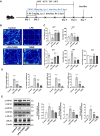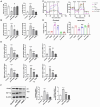THSG counteracts microglial glycolytic reprogramming and neuronal necroptosis both in vivo and in vitro under conditions of neuroinflammation
- PMID: 40596006
- PMCID: PMC12216559
- DOI: 10.1038/s41598-025-05994-y
THSG counteracts microglial glycolytic reprogramming and neuronal necroptosis both in vivo and in vitro under conditions of neuroinflammation
Abstract
Microglial activation, driven by a metabolic shift towards aerobic glycolysis, is implicated in neuroinflammation and neurological disorders like depression. THSG (2,3,5,4'-Tetrahydroxystilbene-2-O-β-D-glucoside), derived from Polygonum multiflorum, exhibits anti-inflammatory and neuroprotective properties, but its mechanisms, particularly its impact on microglial metabolism, are largely unexplored. Using a LPS-induced mouse model of neuroinflammation, we observed that THSG significantly ameliorated depression-like behaviors. It suppressed pro-inflammatory cytokine production (TNF-α, IL-1β, IL-6, iNOS), inhibited microglial activation, and reduced key necroptosis markers (phosphorylated RIPK1, RIPK3, and MLKL) in the hippocampus. Importantly, THSG effectively suppressed LPS-induced activation of the glycolytic pathway in the hippocampus, as evidenced by increased ATP levels, decreased lactate levels, reduced activity of key glycolytic enzymes, and decreased expression of PKM2 and HIF-1α, critical players in microglial glycolysis. Further in vitro studies with BV2 microglial cells confirmed that THSG significantly suppressed glycolytic enhancement, promoting a metabolic shift towards oxidative phosphorylation, thus inhibiting inflammatory activation of microglia. Co-culture experiments of BV2 cells and SH-SY5Y cells further corroborated the in vivo findings, demonstrating that THSG mitigated inflammation-induced necroptosis in SH-SY5Y neurons by reducing phosphorylation of RIPK1, RIPK3, and MLKL, thus protecting neurons from damage. Our results highlight the potential of THSG as a therapeutic agent for neuroinflammatory disorders by modulating microglial metabolic reprogramming and inhibiting neuronal necroptosis.
Keywords: Depression; Metabolic reprogramming; Microglia; Necroptosis; Neuroinflammation; THSG.
© 2025. The Author(s).
Conflict of interest statement
Declarations. Competing interests: The authors declare no competing interests.
Figures







Similar articles
-
Anti-inflammatory mechanism of the MLKL inhibitor necrosulfonamide in LPS- or poly(I:C)-induced neuroinflammation and necroptosis.Biochem Pharmacol. 2025 Sep;239:117021. doi: 10.1016/j.bcp.2025.117021. Epub 2025 Jun 3. Biochem Pharmacol. 2025. PMID: 40473224
-
Irisin ameliorates cognitive impairment in a lipopolysaccharide-induced neuroinflammation mouse model by inhibiting the NLRP3 inflammasome pathway in microglia.Neuropharmacology. 2025 Nov 1;278:110572. doi: 10.1016/j.neuropharm.2025.110572. Epub 2025 Jun 23. Neuropharmacology. 2025. PMID: 40562230
-
Neuroprotective and anti-inflammatory effects of the RIPK3 inhibitor GSK872 in an MPTP-induced mouse model of Parkinson's disease.Neurochem Int. 2024 Dec;181:105896. doi: 10.1016/j.neuint.2024.105896. Epub 2024 Nov 2. Neurochem Int. 2024. PMID: 39491747
-
Microglial activation as a hallmark of neuroinflammation in Alzheimer's disease.Metab Brain Dis. 2025 May 17;40(5):207. doi: 10.1007/s11011-025-01631-9. Metab Brain Dis. 2025. PMID: 40381069 Review.
-
Glucose Metabolic Reprogramming in Microglia: Implications for Neurodegenerative Diseases and Targeted Therapy.Mol Neurobiol. 2025 Jul;62(7):8204-8221. doi: 10.1007/s12035-025-04775-y. Epub 2025 Feb 22. Mol Neurobiol. 2025. PMID: 39987285 Review.
References
MeSH terms
Substances
Grants and funding
LinkOut - more resources
Full Text Sources
Miscellaneous

